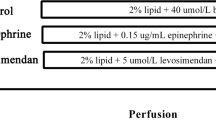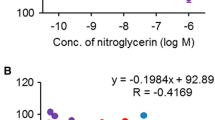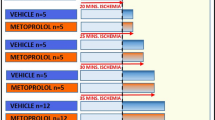Summary
Previous studies have demonstrated pronounced ischemic zone myocardial concentrations of metoprolol following coronary venous retroinfusion in pigs with coronary artery ligation. The effect of coronary venous retroinfusion of metoprolol on myocardial infarct size was studied in 16 pentobarbital-anesthetized open-chest pigs undergoing 60-minute occlusion of the left anterior descending coronary artery followed by 3 hours of reperfusion. Pigs in the experimental group (n=8) were given 0.4 mg/kg (1.0 mg/ml) of metoprolol via the anterior interventricular vein over a period of 5 minutes, beginning immediately after coronary occlusion followed by 0.2 mg/kg/hr intravenously. Control pigs (n=8) received the same volume of saline as the treated group. The risk area and the necrotic area were assessed by monastral blue dye and triphenyl tetrazolium chloride staining, respectively. Metoprolol did not influence hemodynamics. Plasma concentrations of metoprolol were within therapeutic levels. The administration of the beta-blocker resulted in a trend toward reduced norepinephrine concentrations, both in the aorta and coronary vein after coronary occlusion, but it did not prevent norepinephrine overflow following reperfusion. Infarct size expressed as a percentage of the risk area was 77±11% in the control group and 75±12% (mean ± SD; NS) in the treated group. Thus, metoprolol retroinfusion did not reduce infarct size and did not prevent catecholamine overflow after reperfusion. It is concluded that the beneficial effects of metoprolol in acute infarction are probably unrelated to local beta-adrenergic blockade, at least in the pig, an animal with a paucity of coronary collateral blood flow.
Similar content being viewed by others
References
Schömig A. Adrenergic mechanisms in myocardial infarction: Cardiac and systemic catecholamine release.J Cardiovasc Pharm 1988;12:S1-S7.
Holmgren S, Abrahamsson T, Almgren O, Eriksson B-M. Effect of ischaemia on the adrenergic neurons of the rat heart: A fluorescence histochemical and biochemical study.Cardiovasc Res 1981;15:680–689.
Forfar JC, Riemersma RA, Oliver MR. α-Adrenoceptor control of norepinephrine release from acutely ischaemic myocardium: Effects of blood flow, arrhythmia, and regional conduction delay.J Cardiovasc Pharm 1983;5:752–759.
Schömig A, Dart AM, Dietz R, et al. Release of endogenous catecholamine in the ischemic myocardium of the rat. Part A: locally mediated release.Circ Res 1984;55:689–701.
Carlsson L, Abrahamsson T, Almgren O. Local release of myocardial norepinephrine during acute ischemia: An experimental study in the isolated perfused rat heart.J Cardiovasc Pharm 1985;7:791–798.
Baumann G, Riess G, Erhardt WD, et al. Impaired beta-adrenergic stimulation in the uninvolved ventricle post-acute myocardial infarction: Reversible defect due to excessive circulating catecholamine-induced decline in number and affinity of beta-receptors.Am Heart J 1981;101:569–581.
Mukkherjee A, Bush LB, McCoy KE, et al: Relationship between β-adrenergic receptor numbers and physiological responses during experimental canine myocardial ischemia.Circ Res 1982;50:735–741.
Maisel AS, Motulsky HJ, Insel PA. Externalization of β-adrenergic receptors promoted by myocardial ischemia.Science 1985;230:183–186.
Maroko PR, Kjekshus JK, Sobel BE, et al. Factors influencing infarct size following experimental coronary artery occlusions.Circulation 1971;43:67–82.
Reimer KA, Rasmussen MM, Jennings RB. Reduction by propranolol of myocardial necrosis following temporary coronary artery occlusion in dogs.Circ Res 1973;33:353–363.
Kloner RA, Fishbein MC, Cotran SC, et al. The effect of propranolol on microvascular injury in acute myocardial ischemia.Circulation 1977;55:872–880.
Vatner SF, Baig H, Manders WT, et al. Effects of propranolol on regional myocardial function, electrograms, and blood flow in conscious dogs with myocardial ischemia.J Clin Invest 1977;60:353–360.
Vik-Mo H, Maroko PR, Ribeiro LG. Comparative effects of propranolol, timolol and metoprolol on myocardial infarct size after experimental coronary artery occlusion.J Am Coll Cardiol 1984;4:735–741.
Åblad B, Abrahamsson T, Adler G, et al. Cardiac antiischemic effect of metoprolol: Role of β-blockade within the ischemic region.J Cardiovasc Pharm 1987;10:S117-S125.
Wappel M, Zalewski A, Savage M, et al. Myocardial salvage after regional beta-adrenergic blockade.Am Heart J 1989;117:37–42.
Mueller HS, Ayres SM, Religa A, et al. Propranolol in the treatment of acute myocardial infarction. Effect on myocardial oxygenation and hemodynamics.Circulation 1974;49:1078–1087.
Gold HK, Leinbach RC, Maroko PR. Propranolol-induced reduction of signs of ischemic injury during acute myocardial infarction.Am J Cardiol 1976;38:689–695.
Herlitz J, Elmfeldt D, Hjalmarson Å, et al. Effect of metoprolol on indirect signs of the size and severity of acute myocardial infarction.Am J Cardiol 1983;51:1282–1288.
The international collaboration study group. Reduction of infarct size with the early use of timolol in acute myocardial infarction.N Engl J Med 1984;310:9–15.
The MIAMI Trial Research Group. Metoprolol in acute myocardial infarction (MIAMI). A randomised placebo-controlled international trial.Eur Heart J 1985;6:199–226.
Friedman LM, Byington RP, Capone RJ, et al. Beta-blocker heart attack trial research group: Effect of propranolol in patients with myocardial infarction and ventricular arrhythmia.J Am Coll Cardiol 1986;7:1–8.
ISIS-1 (First International Study of Infarct Survival) Collaborative Group. Randomised trial of intravenous atenolol among 16.027 cases of suspected acute myocardial infarction.Lancet 1986;2:57–66.
Otsu F, Carew E, Maroko PR. Myocardial concentration and antiarrhythmic effect of lidocaine administered via coronary veins.J Am Coll Cardiol 1985;5:467A.
Karagueuzian HS, Ohta M, Drury JK, et al. Coronary venous retroinfusion of procainamide: A new approach for the management of spontaneous and inducible sustained ventricular tachycardia during myocardial infarction.J Am Coll Cardiol 1986;7:551–563.
Rydén L, Tadokoro H, Sjöquist P-O, et al. Pronounced accumulation of metoprolol in ischemic myocardium after coronary venous retroinfusion.J Cardiovasc Pharm 1990;15:22–28.
Ervik M, Kylberg-Hanssen K, Johansson L. Determination of metoprolol in plasma and urine using high-resolution gas chromatography and electron capture detection.J Chromatogr 1986;381:168–174.
Eriksson B-M, Persson B-A. Determination of catecholamines in rat heart tissue and plasma samples by liquid chromatography with electrochemical detection.J Chromatogr 1982;288:143–154.
Fishbein MC, Meerbaum S, Rit J, et al. Early phase acute myocardial infarct size quantification: Validation of the triphenyl tetrazolium chloride tissue enzyme staining technique.Am Heart J 1981;101:593–600.
Ebrahimi S, Fishbein MC, Kobayashi S, et al. Overestimation of myocardial infarct size by histologic measurement in a model of occlusion followed by reperfusion.Arch Path Lab Med 1990;114:1218–1222.
Waldenström A, Hjalmarson Å, Thronell L. A possible role of noradrenaline in the development of myocardial infarction.Am Heart J 1978;95:43–51.
Rydén L, Tadokoro H, Sjöquist P-O, et al. Pharmacokinetic analysis of coronary venous retroinfusion.J Am Coll Cardiol 1991;18:603–612.
Klein HH, Schubothe M, Kreuzer H. Temporal and spatial development of infarcts in porcine hearts.Basic Res Cardiol 1984;79:440–447.
Garcia-Dorado D, Theroux P, Elizaga J, et al. Myocardial reperfusion in the pig heart model: Infarct size and duration of coronary occlusion.Cardiovasc Res 1987;21:537–544.
Karlsberg RP, Penhoske PA, Cryer PE, et al. Rapid activation of the sympathetic nervous system following coronary artery occlusion: Relationship to infarct size, site and haemodynamic impact.Cardiovasc Res 1979;13:523–531.
Nadean RA, Champlain J. Plasma catecholamines in acute myocardial infarction.Am Heart J 1979;98:548–554.
Schaub RG, Stewart G, Strong M, et al. Reduction of ischemic myocardial damage in the dog by lidocaine infusion.Am J Pathol 1977;87:399–414.
Hatori N, Drury JK, Satomura K, et al. Profound infarct size reduction with lidocaine compared to bretylium antiarrhythmic therapy in an acute coronary occlusion/reperfusion model in pigs.Circulation 1986;74(Suppl II):260.
Kerber RE, Martin JB, Sascho JA, et al. Effects of direct-current countershocks on regional myocardial contractility and perfusion. Experimental studies.Circulation 1981;63:323–332.
Miura M, Thomas R, Gunz W, et al. The effect of delay in propranolol administration on reduction of myocardial infarct size after experimental coronary artery occlusion in dogs.Circulation 1979;59:1148–1157.
Reynolds RD, Burmeister WE, Gorczynski RJ, et al. Effects of propranolol on myocardial infarct size with and without coronary artery reperfusion in the dog.Cardiovasc Res 1981;15:411–420.
Jang I-K, Van de Weff F, Vanhaecke J, et al. Coronary reperfusion by thrombolysis and early beta-adrenergic blockade in acute experimental myocardial infarction.J Am Coll Cardiol 1989;14:1816–1823.
Tomoike H, Ross J Jr, Franclin D, et al. Improvement by propranolol of regional myocardial dysfunction and abnormal coronary flow pattern in conscious dogs with coronary narrowing,Am J Cardiol 1978;41:689–696.
Becker LC, Rortuin NJ, Pitt B. Effect of ischemia and antianginal drugs on the distribution of radioactive microspheres in the canine left ventricle.Circ Res 1971;28:263–269.
Buck JD, Hardman HF, Warltier DC, et al. Changes in ischemic blood flow distribution and dynamic severity of a coronary stenosis induced by beta blockade in the canine heart.Circulation 1981;64:708–714.
Geary GG, Fenton L, Cheng G, et al. Failure of pretreatment with propranolol to reduce the zone of myocardial infarction after two hours of coronary occlusion in the primate heart.Am J Cardiol 1983;52:615–620.
Savage RM, Guth B, White FC, et al. Correlation of regional myocardial blood flow and function with myocardial infarct size during acute myocardial ischemia in the conscious pig.Circulation 1981;64:699–707.
Fujiwara H, Ashraf M, Sato S, et al. Transmural cellular damage and blood flow distribution in early ischemia in pig hearts.Circ Res 1982;51:683–693.
Dolder M, Althans U, Gurtner HP, et al. Einfluss von pindolol und grösse und hemodynamik des experimentellen myokardinfarktes beim schwein.Schweiz Med Wschr 1977;107:1586–1578.
Zalewski A, Goldberg S, Dervan JP, et al. Myocardial protection during transient coronary artery occlusion in man: Beneficial effects of regional β-adrenergic blockade.Circulation 1986;73:734–739.
Murry CE, Jennings RB, Reimer KA. Preconditioning with ischemia: A delay of lethal cell injury in ischemic myocardium.Circulation 1986;74:1124–1136.
Schott RJ, Rohmann S, Braun ER, et al. Ischemic preconditioning reduces infarct size in swine myocardium.Circ Res 1990;66:1133–1142.
Author information
Authors and Affiliations
Rights and permissions
About this article
Cite this article
Kobayashi, S., Tadokoro, H., Rydén, L. et al. Local beta-adrenergic blockade does not reduce infarct size after coronary occlusion and reperfusion: A study of coronary venous retroinfusion of metoprolol. Cardiovasc Drug Ther 7, 159–167 (1993). https://doi.org/10.1007/BF00878325
Received:
Accepted:
Issue Date:
DOI: https://doi.org/10.1007/BF00878325




